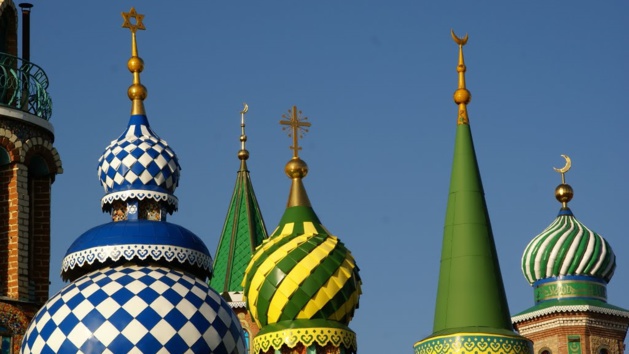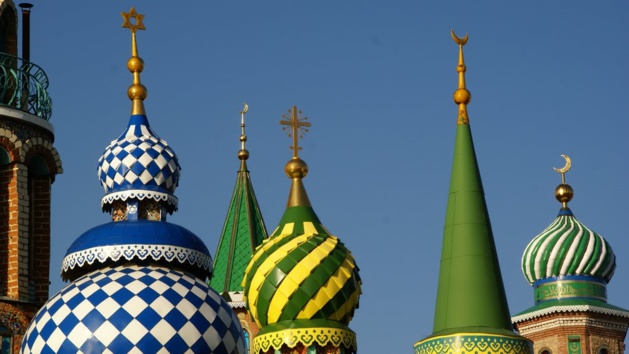
Credit RR
Founded around the year 100, Kazan is one of the most ancient metropolises of Eastern Europe, after Prague and Kiev. The capital of Tatarstan, a Russian province with a rich and ancient history, it is the third most touristic city in Russia, after Moscow and Saint Petersburg.
Its main attraction is the Kazan Kremlin, built during the Muslim period of the Golden Horde and of the Khanate of Kazan. Conquered by Ivan the Terrible in 1552 and erected into a Christian centre of the countries of the Volga, the Kazan Kremlin is the only Tatar fortress remaining in Russia and it is today an important pilgrimage site.
A unique meeting place
But for the past two decades, on the banks of the Volga, another building just as outstanding attracts the attention of the inhabitants and tourists. At first sight, an Orthodox church somewhat original, or even fanciful, with oriental inspirations and multiple towers.
Except that at the top of one of those towers, next to the traditional crosses, we can see the stars of David, crescent moons and Chinese domes. Far from being a mere church, this “universal Temple” presents itself as a place of sharing and a meeting place for all religions.
A gigantic architectural complex, the “universal Temple” cannot be defined as a mere conglomerate of mosques, synagogues, churches and other Buddhist temples. On the contrary, no prayer, no mass, no ceremony are ever celebrated in it, no altar and no minaret are set up.
The reason for it is more evident than it appears: for the project initiator, Ildar Khanov, the idea has never been to “merge all religions in one, because they all have their own history and their own cultural necessity”. His first goal was to “bring them together, to give them a meeting and communication place. It is not a place of worship, but of culture”, he confided to Le Figaro in 2012.
The fruit of a revelation
However, Christ himself may have asked the artist to devote himself to such a project, a night of 1994 during which he reportedly appeared to him and told him “you will get up at dawn, you will take a shovel in the shed, and you will start building a universal temple”.
Such an intervention was timely. It must be said that, at that time, Ildar Khanov was totally idle. After having studied in the Surikov Institute, Moscow’s art school, during the 1960s, he returned to Tatarstan and started to work. Naberezhnye Chelny, a city located 225 km from Kazan, is since 1970 full of sculptures and fountains by the monumentalist painter and sculptor.
Member of the USSR Union of Painters, Ildar Khanov worked and mainly lived thanks to orders made by the State and the Party. But with the progressive decline of the USSR and the Perestroika of Gorbachev, work became rare, then nonexistent. This divine intervention and this new order allowed him to find a new means to express his art and his multiple talents.
A global project
In 1943, while he was only 3 years old, Christ appeared to Ildar during a near death experience. According to him, he then acquired gifts of clairvoyance and of healing, which, with the learning of acupuncture and Chinese medicine, allowed him to cure all ills. He reportedly received around 300 patients per day for several years in the enclosure of the complex where the Temple stands.
Indeed, the latter only represents a little part of the huge project of the artist, who would eventually have wanted to “create an ecumenical centre of history and spirituality, an art school for children, an orphanage, a detoxification centre, a pictorial art museum”, a place where bodies and spirits could be cured.
Even more ambitious, Ildar Khanov plans to build a new city a little lower on the banks of the Volga. It would be equipped with medical and cultural structures such as a big detoxification centre, an orphanage, a conservatoire etc. This project also envisions the building of the biggest memorial dedicated to the Shoah in the world.
These monumental projects will probably never surface: Ildar Khanov died in 2013 at the age of 74. Although the “universal Temple” already stands on the shores of the Volga, it only brings together four religions out of the sixteen that the artist wanted to gather.




























